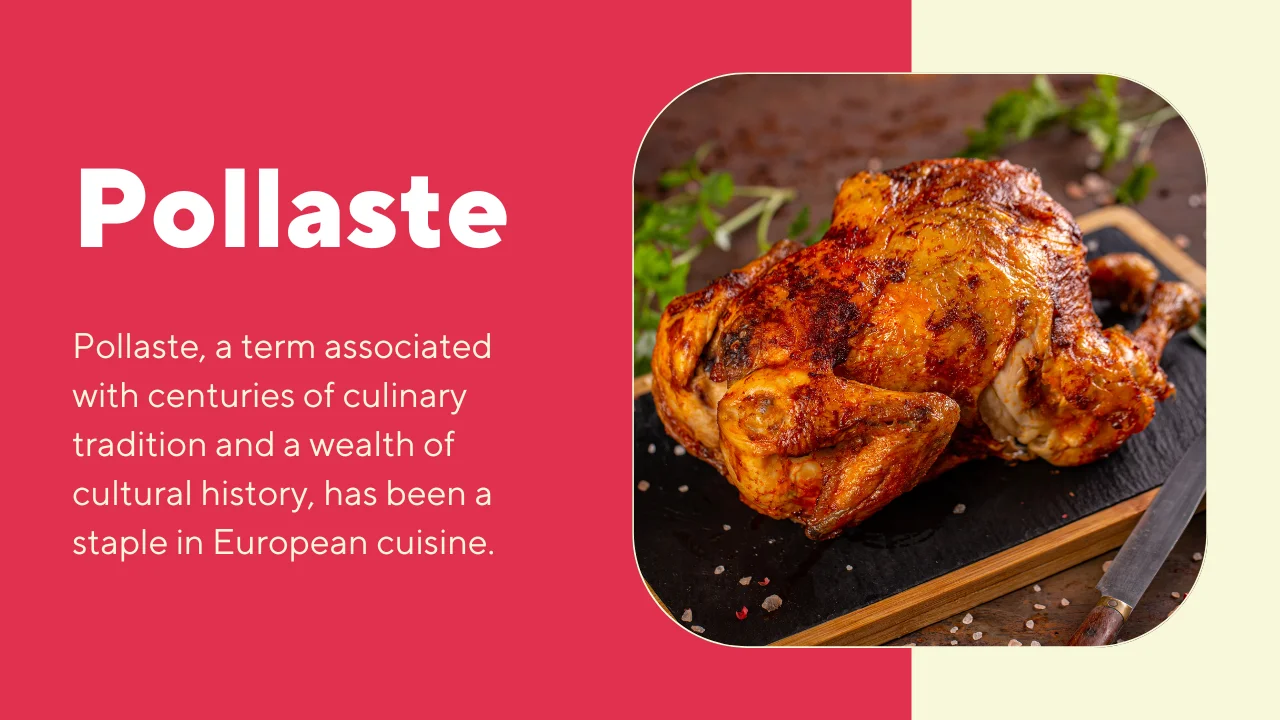Pollaste, a term associated with centuries of culinary tradition and a wealth of cultural history, has been a staple in European cuisine. Pollaste represents a fusion of art and flavour that many enjoy, whether it’s the elaborate, layered pastry of Spain or the robust poultry dishes of Estonia. Here we’ll delve into the history, different kinds, and preparation of Pollaste, as well as its significance in Spanish and Estonian cuisines.
What is Pollaste?
Instead of being just one dish, pollaste is an idea that unites two distinct but complementary culinary heritages. Layers of pastry, typically filled with anything from sweet creams to savoury vegetables, make up Pollaste, a traditional Spanish dish. Pollaste is an Estonian word for a robust chicken dish that is full of earthy flavours from roasted veggies, herbs, and garlic. Both versions are unique, but they have one thing in common: they both highlight healthy ingredients and use methods that improve the texture and flavour.
Pollaste in Spanish Cuisine
As a pastry that is both visually beautiful and tasty, Spanish Pollaste has a long and storied history. Let’s take a closer look at what makes this Pollaste version unique.
Traditional Spanish Pollaste Pastry
Layered pastries are the usual form of Pollaste in Spain. The layers are made with rich doughs that are frequently laminated to get a flaky, light texture. These pastries can have a wide variety of fillings. Sweet varieties often include fruits, creams, and occasionally nuts, whereas savoury ones typically include chicken or pork mixed with veggies and spices.
Sweet vs. Savory Pollaste Pastries
The adaptability of Pollaste is a major factor in its popularity in Spain. Sweet Pollaste pastries are a favourite among guests at social events due to their fillings of almonds, honey, and custards. The savoury Pollaste, on the other hand, is a common main dish or appetiser. Roasted chicken, bell peppers, and manchego are some of the most popular savoury fillings.
Culinary Techniques for Perfect Pollaste Pastry
The processes involved in creating Pollaste necessitate accuracy. The flaky layers that characterise pastry are made by laminating the dough. Like when you make puff pastry or croissants, you’ll need to fold the butter into the dough several times. To make sure every layer bakes evenly, bakers should keep the dough consistency consistent throughout.
Pollaste Pastry Across Spain
Catalonia, Valencia, and Andalusia are the places you’re most likely to find pollaste pastries in a bakery or market. Every area gives the food its unique flavour. Valencian Pollaste with prawns and mussels is a popular choice, while Catalonian Pollaste may be filled with a combination of regional sausages and beans. This variation across regions highlights how versatile Pollaste is as a dish.
Modern Twists on Spanish Pollaste
Modern Spanish chefs have taken Pollaste and run with it, giving it their own spin. Fillings such as foie gras or truffles are served in some restaurants’ Pollaste. The humble pastry has transformed into something fit for gourmet dining with the addition of these luxurious ingredients, demonstrating how this dish has progressed through the years.
Pollaste in Estonian Cuisine
In contrast to the elaborate pastry version of Pollaste found in Spain, the traditional rural dish of Estonia is mainly a savoury poultry dish. Indulge in the hearty, comforting flavours of Estonian Pollaste as you gather your family around the dinner table.
The Heart of Estonian Pollaste: Chicken
Roasted or grilled chicken is the main ingredient in Estonian Pollaste. The emphasis in Estonian Pollaste is on fresh, high-quality ingredients and simplicity, in contrast to its Spanish pastry equivalent. Common seasonings for chicken include garlic, olive oil, and herbs like rosemary and thyme. The comforting and satisfying nature of Estonian Pollaste is due to its simple yet flavourful combination.
Estonian Pollaste Cooking Techniques
Roasting or grilling is a common way to prepare pollaste in Estonia. Roasting chicken makes the skin crispy and the meat juicy and tender all at the same time. However, the chicken takes on a smokier flavour when grilled, which enhances the dish’s complexity. Traditional cooking methods, such as using open flames or wood-fired ovens, are still widely practiced, especially in rural Estonia.
Vegetables in Estonian Pollaste
Vegetables such as potatoes, carrots, and onions are common accompaniments to pollaste. Roasting the veggies with the chicken allows them to soak up all the delicious juices that come out of the meat. The end product is a dish that is full of flavour, with a rich earthiness. Incorporating seasonal vegetables here and there reflects the farm-to-table philosophy that underpins traditional Estonian cuisine.
Herbs and Spices in Estonian Pollaste
Estonian Pollaste gets its distinctive flavour from the herbs that are used to make it. Common herbs include rosemary and thyme, but dill and parsley also see heavy use. Light and hearty thanks to the herbs and the natural flavours of the roasted chicken and veggies, this dish is ideal for a winter night in Estonia.
The Role of Pollaste in Estonian Celebrations
For Estonians, pollaste is more than simply a commonplace meal. It is a staple in holiday feasts, particularly Christmas and other celebrations. Gathering around a roasted Pollaste with fresh bread and a variety of side dishes is a great way for families to spend quality time together.
Pollaste: A Symbol of Culinary Tradition
Both the Spanish and Estonian versions of pollaste are very important culturally. What matters most are the traditions and memories shared over the meal, not the food itself. Pollaste is a representation of the innovation, artistry, and familial hospitality of these two illustrious European traditions, whether it’s a delectable pastry or a filling dinner.
Preserving the Tradition of Pollaste
There has been an effort to maintain the Pollaste tradition in Estonia and Spain, even though new interpretations have emerged. To ensure that this traditional recipe is preserved for generations to come, cooking schools in Spain teach students how to make Pollaste pastry. Traditional Pollaste is still served in small, family-owned restaurants in Estonia, preserving its position as the national dish.
Pollaste in Modern Cuisine
Pollaste has re-established itself on the world stage amidst the current trend of fusion and experimentation in cuisine. Whether it’s the rustic flavours of Estonian chicken dishes or the layering techniques of Spanish pastries, chefs all over the globe are putting Pollaste touches into their dishes. Incorporating modern techniques into classic recipes is a growing trend, and this is just one example.
Pollaste and Health Considerations
Pollaste can be customised to fit different dietary preferences, which is great news for the growing trend of health-conscious eating. To make Pollaste pastry gluten-free, try using whole wheat flour instead of white. For the Estonian chicken dish, try using organic, free-range chicken and veggies from your local market. With these updates, Pollaste can keep up with the health-conscious food scene of today.
Pollaste in Culinary Schools
Culinary schools, especially those that focus on European cuisine, are including Pollaste in their curricula as it becomes more well-known around the world. Learners of traditional cooking techniques learn the ins and outs of making Pollaste, with an emphasis on the steps necessary to achieve flawless layering and seasoning.
FAQs
What is Pollaste in Spanish cuisine?
Pollaste in Spanish cuisine refers to a layered pastry that is either sweet or savory, filled with various ingredients such as meats, vegetables, fruits, or creams.
How is Pollaste different in Estonia?
In Estonia, Pollaste refers to a hearty dish made with roasted or grilled chicken, typically seasoned with herbs and served with vegetables.
Can Pollaste be made with meats other than chicken?
Yes, while chicken is traditional in Estonia, other meats like pork or beef can also be used in Pollaste, especially in modern variations.
How long does it take to bake Pollaste pastry?
The baking time for Pollaste pastry depends on the size and ingredients but typically ranges between 25 to 40 minutes for a well-cooked, crispy finish.
What herbs are commonly used in Estonian Pollaste?
Common herbs used include rosemary, thyme, dill, and parsley, adding aromatic and earthy flavors to the dish.
Also Read: Çeciir: Taste The Turkish Culinary Delight
Conclusion
For many people across many different cultures and time periods, eating pollaste has been a shared culinary tradition. Pollaste is a beloved dish in both home cooking and gourmet dining, whether you prefer the delicate layers of Spanish pastry or the robust, rustic flavours of Estonian chicken. It symbolises the fusion of simplicity and complexity.
As we’ve seen, Pollaste is deeply ingrained in the cultural traditions of Estonia and Spain, providing a glimpse into the long traditions, inventiveness, and hospitality of these countries. With a touch of modernity, Pollaste keeps evolving while staying true to its roots; it goes well with both sweet and savoury dishes thanks to its versatility.
The ultimate message of Pollaste is to enjoy every step of the cooking and serving process, not only the finished product. The most beloved meals are those that are prepared with love, honouring both tradition and creativity while creating flavours that are sure to be enjoyed for years to come. No matter your level of experience in the kitchen, Pollaste gives you the chance to discover new things, try different things, and enjoy being creative in the kitchen.

Diane Wood is a talented blogger at Vistazens.com, covering a wide range of subjects, including technology and culture. Her work highlights the connections between modern life and long-standing traditions, while simplifying the latest innovations and sustainability efforts for readers.

